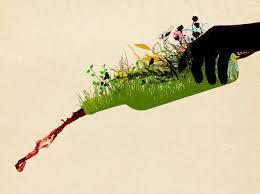How wineries of today are using environmental credentials to gain a marketing advantage
Sustainability and environmental consciousness has been gaining ground in the wine industry for a least a decade, and as the vintages fly by, it continues to gather momentum.
Employing sustainable practices, looking after the land, reducing environmental impact, and the mandate of being caretaker for the generations to come is a real-time and relevant cause for many modern day wineries and wine grape growers. In fact we would go as far as to say that it’s now considered bad business if a brand doesn’t take some responsibility for the footprint it leaves. In an industry striving for sustainability, demonstrating some level of environmental consciousness now means staying competitive.
However the flip side of this is that it costs money to be green. Every winery, big and small, still needs to make a dollar and therefore an environmental strategy, as a part of a business and marketing strategy, needs to make both financial and sustainable sense. A ‘green’ strategy should not only benefit the environment and provide your organisation some environmental credentials to toast about, it should also benefit the brands positioning, appeal to a relevant target market, and boost the bottom line.
What does it mean to a winery to be environmentally aware?
These days words like ‘environmentally aware’ or ‘sustainable’ are frequently used in wine marketing jargon and their true meaning as a result has become diluted and a little bit ambiguous. For a winery to be committed to their environmental strategy they must:
- Fully understand this audience, their specific target market within this audience, and what these particular consumers are looking for in a wine offering. This target market, although growing, is still significantly smaller that the general commercial wine market and so need to be directly targeted.
- The winery must be true and unwavering in their commitment to their environmental strategy. If they say they are doing it, they need to be able to prove they are.
- Ensure they price their product in a manner that is commercially viable for their business and fits within their target market price bracket.
This last point is of course the one on which success hinges and the hardest of the three to achieve. True sustainable practices and environmental offerings are often more expensive to produce and the target market that they appeal to are not necessarily able to shop in higher price brackets. However, in the long term, many environmental strategies can both allow consumers to enjoy a conscious product, but can cut costs and add value. These credentials need be thought of as an investment in the future of both the land and the brand.
The rise of Australian wine organisations that focus on this issue
Following the rise in awareness of environmental concern and consciousness, a number of organisations in Australia have formed. These organisations focus solely on wineries and vineyards, are committed to building awareness of these practices, and to aiding those businesses within the industry who are interested in employing environmentally-friendly practices. One such organisation is the Winemakers Federation of Australia’s Entwine Initiative, which has the overall objective of focusing on the overall environmental impact wineries are having. They specifically encourage various waste minimisation and pollution prevention strategies to improve the sustainability of its members.
Is there a market for these offerings?
The simple answer to this question is yes, and demand is growing. For both Australian and international wine consumers, (where a significant percentage of our wine product is exported and enjoyed) it is becoming more important to consumers that the wine that they drink is produced with an eye to the future. Consumers are therefore more susceptible and more responsive to those that take the time to include sustainable strategies in their business operations.
What are some of the most popular environmental credentials used in wine marketing today?
There are a number of practices that wineries can employ to provide them with the opportunity to include environmental credentials in their marketing armoury. Some of the widely adopted sustainable practices are detailed below. These practices are brought to life using examples from a number of Australian wineries. These examples show how these wineries are using green practices to their advantage while also allowing them to offer wine consumers products that they can enjoy guilt-free.
Water efficiency: Growing grapes and making wine uses a significant amount of water, a very precious resource in today’s drought stricken environment. Wineries can make a difference to both their impact on the environment and their bottom line, if they use, and re-use water in a smart way.
- Burch Family Wines recycles all of the wastewater created in its production practices for future irrigation growing purposes. They also have a large water tank used to gather all of the rainwater that falls on their roofs to be used around the vineyard.
Energy efficiency: A winery and its often-times 24/7 operations consumes a significant volume of electricity and energy throughout the year. Finding ways to conserve energy use, designing new practices, or creating their own energy sources, like solar panels, is an important way to create valuable environmental credentials that consumers can understand.
- At Gemtree Wines who are passionate about sound environmental practices, sustainable agriculture and innovation, both in the vineyard and the winery, they have installed a 400 panel solar system that will save the winery 151,758Kw per annum in electricity consumption, which is over 110 tonnes of green house emissions. This is the equivalent of planting 11,000 trees a year.
Soil quality, pest management and controlled use of organic chemicals and pesticides: Harmful chemicals destroy soil quality, natural ecosystems and the health of the soil. Some winemakers believe this has a direct affect on the taste of the wine. Many wineries now use effective pest management strategies, organic chemicals and pesticides, and some are even pesticide free.
- Cape Mentelle’s environmental initiatives include using natural fertilisers, free-range guinea fowl for weevil control, undervine mowing and cultivation control for weeks and weevils, and grazing sheep are used to maintain weeds/grass in the vineyards during winter to minimise mowing and use of herbicides.
Waste management and recycling: reducing output, re-using materials and recycling where possible are all ways for a winery to reduce their footprint and save money.
- At Bremerton Wines the increased use of recycling vessels means that they are recycling more, reducing their general rubbish to a minimum, cutting landfill contribution and their waste removal bill.
Wildlife habitat conservation: Wineries are often located on beautiful parcels of land that are home to all manner of wildlife species. With some endeavour it is possible for these critters to live within the vineyards in harmony and to even enrich the soils and wines. Consumers are also particularly sensitive and supportive to the preservation of wildlife and so this credential has punch.
- Banrock Station employs a very successful strategy of giving back, and is committed to wildlife and environmental conservation. Physically set in an eco-wetlands conservation area in the Riverland, the brand also loudly promotes its planet projects to garner consumer support and confidence. It clearly states on all of its labelling, and in all of its communications, that with every purchase of Banrock Station wine, you are helping to protect the planet. It backs this up with facts, figures and information on their website if anyone is ever in doubt. Powerful environmental marketing credentials indeed.
Organic practices: Organic wines are wines made with certified organically grown grapes from vineyards that follow the guidelines set by the countries national body. This generally means that the grapes are grown without using any synthetic pesticides or non-organic chemicals. It also means that the wine itself cannot have added sulphates and preservatives to prolong shelf life. Being able to claim that a wine is organic means that it can be very desirable for some consumers in a market where many people are very conscious of what they eat and drink.
- Pure Vision Wines have very successfully positioned their brand as an organic wine brand. It is intricately woven throughout every aspect of their marketing, along with the fact that their wines are also vegan and preservative free. They have very specifically targeted this consumer with clever, organic branding and labelling and offer detailed information about these practices on their labels and website.
Biodynamic practices: Biodynamic grape growing and winemaking takes this one step further and treats the vineyard as a closed loop, employing organic practices and natural alternatives for eliminating waste and promoting a healthy ecosystem. This can involve the following practices: no use of synthetic pesticides or non-organic chemicals; use of compost teas and natural preparations to enrich soil and promote microorganisms; insectaries to control pests; planting, harvesting and pruning determined by the phases of the moon. In the scheme of the total wine industry, biodynamic wineries are a minority, however, there is definitely a target market for these wines and some wineries have very successfully captured these consumers.
- Whistling Kite Biodynamic Wines is a true producer of biodynamic wines and over two decades have cultivated a successful but small consumer following based on this credential alone. They farm both traditional and alternative varieties, all of which have unique flavour and drinking experience, expressing the variety’s character and reflecting the unique terroir of the vineyard.
In conclusion
With the rise of organic, biodynamic and pesticide-free wine offerings, and the quest to achieve true terroir in the bottle, having some sort of environmental boast has now almost become a given in today’s wine world. However, ensuring that an environmental strategy boosts and not cripples business is also essential and therefore carefully choosing a sustainable strategy that is authentic and achievable is essential for all wineries, big and small.
Image credit: http://radio.krcb.org/post/keys-sustainability-wine-industry-and-beyond#stream/0
Blogs, websites, articles and journals referenced in the research and writing of this article
- https://www.awri.com.au/wp-content/uploads/2013/01/1792-abbott-WVJ-31-1-2016.pdf
- https://www.smartcompany.com.au/business-advice/strategy/what-the-wine-industry-needs-for-a-sustainable-future/
- https://www.adelaidehillswine.com.au/region/environment/
- https://discovercaliforniawines.com/sustainable-winegrowing/
- https://www.chicagotribune.com/dining/drink/wine/ct-environment-friendly-wine-20171114-story.html
- http://www.bremerton.com.au/?method=pages.showPage&PageID=84aa5092-ee06-1875-e38f-66b9a27ce255&originalMarketingURL=Vineyards/Environment/Environmental-Policy
- https://winesvinesanalytics.com/template.cfm?content=58066§ion=features
- https://gemtreewines.com/our-story/
- https://www.capementelle.com.au/Winemaking/Sustainable-Practices
- http://www.classaenergysolutions.com.au/gemtree-winery-99kw/







